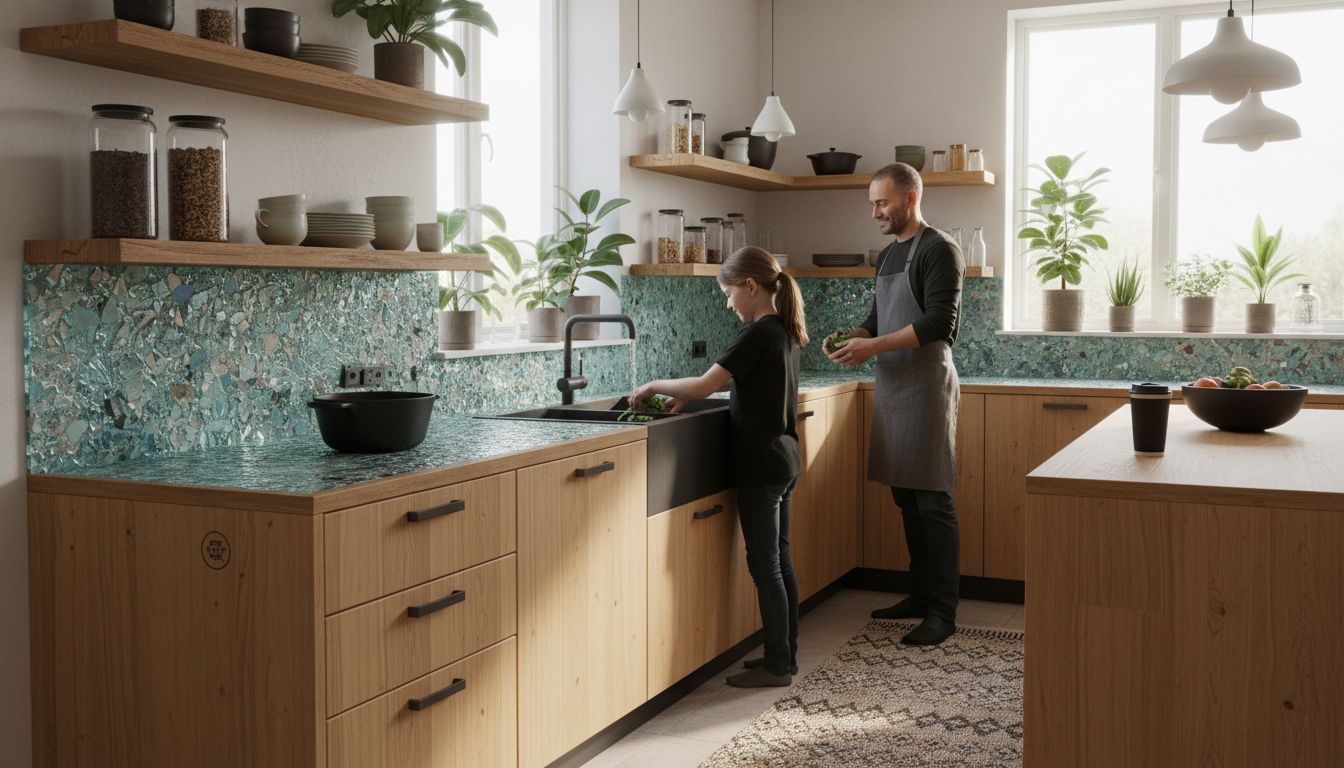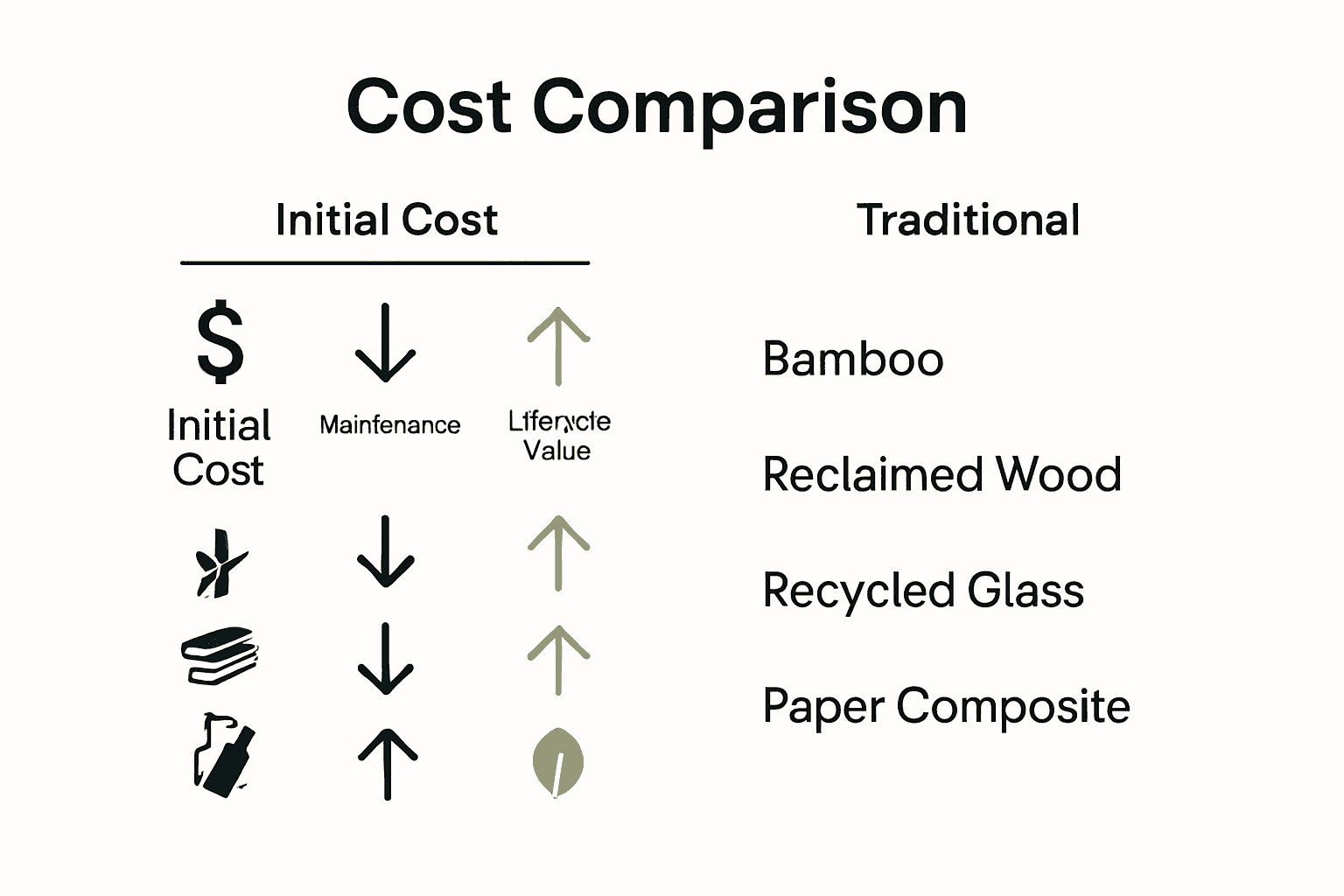Complete Guide to Sustainable Kitchen Materials
- demoore5506
- 13 minutes ago
- 6 min read

Nearly 40 percent of household waste can be traced to poor material choices in home renovations. Every decision about kitchen surfaces, cabinets, or tools quickly adds up, both for the planet and your own health. Choosing sustainable kitchen materials matters because it shapes not just the look of your space but also your impact on the environment. Discover how eco-friendly options offer durability, safer ingredients, and smarter value for homeowners who care about making responsible choices.
Table of Contents
Key Takeaways
Point | Details |
Sustainable Material Characteristics | Focus on renewable sourcing, low carbon manufacturing, non-toxic production, and recyclability to minimize environmental impact while enhancing functionality. |
Material Categories | Consider using reclaimed wood, bamboo, recycled metals, and composite materials for eco-friendly kitchen designs that also provide durability and style. |
Life Cycle and Maintenance | Prioritize materials that are resilient, easy to maintain, and designed to last, ensuring ongoing environmental and health safety. |
Economic Advantages | Assess long-term financial benefits of sustainable materials, including reduced maintenance costs and increased property value, despite higher initial expenses. |
Defining Sustainable Kitchen Materials
Sustainable kitchen materials represent more than a trend - they’re a critical approach to designing environmentally responsible cooking spaces that minimize ecological impact while maximizing functionality. According to davidsuzuki.org, these materials are characterized by their renewable nature, minimal environmental footprint, and commitment to both planetary and personal health.
Sustainable materials prioritize several key characteristics that distinguish them from conventional options:
Renewable sourcing
Low carbon manufacturing processes
Non-toxic production methods
Biodegradability or long-term recyclability
Minimal chemical treatment
As ecoparent.ca highlights, the goal is striking a delicate balance between environmental responsibility and practical kitchen utility. This means selecting materials that not only reduce ecological harm but also provide durability, performance, and aesthetic appeal.
Primary sustainable kitchen material categories include natural wood, bamboo, recycled metals, and responsibly sourced composite materials. These options offer significant advantages over traditional petrochemical-based or heavily processed alternatives. By carefully selecting materials that are ethically sourced, minimally processed, and designed for long-term use, homeowners can create kitchen environments that support both ecological wellness and personal lifestyle needs.

For a comprehensive understanding of integrating sustainable design principles, check out our guide on understanding sustainable kitchen design.
Eco-Friendly Material Types and Sources
Sustainable kitchen materials have evolved far beyond simple aesthetic choices, representing a comprehensive approach to environmental responsibility and design innovation. rtadepot.ca highlights several standout materials that are transforming kitchen design while minimizing ecological impact.
Primary Sustainable Material Categories
Some of the most promising eco-friendly kitchen materials include:
Reclaimed Wood: Reduces landfill waste and provides unique visual character
Bamboo: Offers rapid renewability and exceptional strength
FSC-Certified Wood: Ensures responsible forestry practices
Recycled Glass: Creates durable, non-porous surfaces
Paper Composite: Innovative material offering water resistance and sustainability
According to jatobakitchens.ca, these materials demonstrate that sustainability doesn’t require compromising style or functionality. Recycled glass countertops, for instance, provide exceptional durability, while paper composite materials deliver water-resistant surfaces that challenge traditional design limitations.
The key to selecting sustainable materials lies in understanding their lifecycle, manufacturing process, and long-term environmental impact.
By prioritizing materials with minimal processing, renewable sources, and potential for recycling or biodegradation, homeowners can create kitchen spaces that are both environmentally responsible and aesthetically compelling.
For more insights into integrating these sustainable design principles, explore our guide on understanding sustainable kitchen design.
Durability, Maintenance, and Performance Factors
Selecting sustainable kitchen materials requires careful consideration of their long-term performance, maintenance needs, and durability. ecoparent.ca emphasizes that true sustainability goes beyond initial environmental impact and must include the material’s ability to withstand daily kitchen demands.
Key Performance Characteristics
Sustainable materials must excel in several critical areas:
Resilience: Ability to resist wear and tear
Maintenance Requirements: Ease of cleaning and upkeep
Longevity: Lifespan before replacement is necessary
Resistance to Moisture and Stains: Performance under typical kitchen conditions
Non-Toxic Treatment: Ensuring ongoing environmental and health safety
According to davidsuzuki.org, materials like bamboo and natural wood offer exceptional durability when properly maintained. The key is selecting products with non-toxic finishes and implementing appropriate care strategies that preserve both the material’s structural integrity and its eco-friendly attributes.
Homeowners should approach sustainable materials as investments, recognizing that proper maintenance extends their usable life and maximizes their environmental benefits. This means regular cleaning, avoiding harsh chemicals, protecting surfaces from extreme conditions, and addressing minor repairs promptly. By understanding each material’s specific care requirements, you can ensure your kitchen remains both beautiful and environmentally responsible for years to come.
To learn more about integrating sustainable design principles, explore our guide on understanding sustainable kitchen design.
Comparing Costs Versus Traditional Materials
When considering sustainable kitchen materials, homeowners often encounter a critical question: do eco-friendly options truly make financial sense? rtadepot.ca provides valuable insights into the nuanced economic landscape of sustainable kitchen investments, revealing that initial costs tell only part of the story.
Cost Breakdown Analysis
Sustainable materials present a unique value proposition:
Upfront Costs: Often higher than traditional materials
Long-Term Savings: Reduced maintenance and replacement expenses
Property Value: Potential increase in home marketability
Environmental Impact: Indirect financial benefits through resource conservation
Durability: Extended lifecycle compared to conventional materials
According to jatobakitchens.ca, materials like recycled glass and paper composite countertops demonstrate that higher initial investments can translate into significant long-term financial advantages. These materials typically offer superior durability, lower maintenance requirements, and contribute to a healthier living environment.
The true economic calculation extends beyond immediate price tags.

Sustainable materials often provide enhanced longevity, reduced replacement frequency, and potential energy efficiency improvements. Homeowners should view these choices as strategic investments that deliver financial returns through decreased lifecycle costs, improved home value, and reduced environmental impact.
To understand more about budget-friendly kitchen upgrades, explore our guide on the cost of cabinet painting in 2025.
Upgrading Cabinets With Sustainable Solutions
Transforming kitchen cabinets into eco-friendly masterpieces requires strategic material selection and thoughtful design approaches. rtadepot.ca provides compelling insights into sustainable cabinet upgrades that blend environmental responsibility with aesthetic innovation.
Sustainable Cabinet Upgrade Strategies
Homeowners have multiple pathways to create environmentally conscious cabinet solutions:
Reclaimed Wood: Unique character, reduced waste
Bamboo: Rapid renewability, exceptional strength
FSC-Certified Wood: Ensures responsible forestry practices
Recycled Materials: Minimizes environmental footprint
Low-VOC Finishes: Reduces harmful chemical emissions
According to jatobakitchens.ca, integrating materials like recycled glass and paper composite can dramatically transform cabinet aesthetics while maintaining environmental integrity. These innovative materials offer durability, low maintenance requirements, and a commitment to sustainable design principles.
The upgrade process involves more than material selection. Homeowners must consider the entire lifecycle of their cabinet materials, from sourcing to potential future recycling. This holistic approach means prioritizing materials with minimal environmental impact, choosing local suppliers when possible, and selecting finishes that extend the cabinets’ functional lifespan while minimizing ecological harm.
To explore budget-friendly approaches to kitchen upgrades, check out our guide on saving money with cabinet refinishing.
Elevate Your Kitchen with Sustainable Cabinet Refinishing
Choosing sustainable kitchen materials is an important step toward creating an eco-friendly cooking space that balances durability, beauty, and environmental responsibility. Yet homeowners often face the challenge of upgrading their kitchens without the heavy costs or waste associated with full cabinet replacements. If you value renewable materials like bamboo or reclaimed wood but want a solution that minimizes disruption and respects your budget, transforming your existing cabinets can be the perfect answer.
At Ottawa Cabinet Painting, we specialize in high-quality cabinet painting and refinishing that aligns with sustainable goals. Our meticulous process extends the life of your current cabinetry and provides a smooth, durable finish using premium, low-VOC paints that support healthier indoor environments. By choosing refinishing, you reduce waste and embrace eco-friendly design without sacrificing style or function. Ready to enhance your kitchen sustainably and affordably Today discover our professional cabinet painting services and take the first step toward a greener kitchen you will love.
Frequently Asked Questions
What are sustainable kitchen materials?
Sustainable kitchen materials are those that are sourced and manufactured with minimal environmental impact. They prioritize renewable sourcing, low carbon manufacturing processes, non-toxic production methods, biodegradability, or long-term recyclability, while also being durable and aesthetically pleasing.
How do I ensure the durability of sustainable materials in my kitchen?
To ensure durability, choose materials known for their resilience, such as bamboo or reclaimed wood. Regular maintenance, avoiding harsh chemicals, and proper care strategies can also extend the lifespan of these materials.
Are sustainable kitchen materials more expensive than traditional options?
While sustainable kitchen materials often have higher upfront costs, they can lead to long-term savings due to reduced maintenance, lower replacement expenses, and potentially increased property value through energy efficiency and enhanced marketability.
What types of sustainable materials are recommended for kitchen cabinets?
Recommended sustainable materials for kitchen cabinets include reclaimed wood, bamboo, FSC-certified wood, recycled materials, and low-VOC finishes, which help reduce harmful chemical emissions while providing durability and aesthetic appeal.
Recommended

Comments